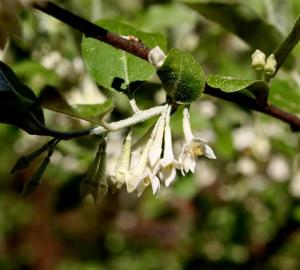This native of eastern Asia can now be found from Maine to Virginia, and west to Wisconsin. This species now seriously competes with native species, and has been listed as a Noxious species in 22 north, central, and western counties of West Virginia. It is considered more invasive in the eastern part of North America than in the western part. Other than West Virginia, Connecticut has banned it as Invasive; Massachusetts and New Hampshire have it listed as Prohibited.
In the 1830’s Autumn Olive was introduced from China and Japan as an ornamental and as wildlife habitat, and to restore land that was degraded due to deforestation. Indeed the animals do eat the fruit. It will attract birds, black bear, opossum, raccoon, and skunk to the fruit which contribute to its spread through their dung distributing the seeds. Deer are drawn to the twigs and foliage. And the nectar draws bees, butterflies, and hummingbirds!
The berries are also edible by humans, being juicy and acidic, they can be used raw or made into jams or jellies. The Vitamin C content is approximately 12 mg per 100 g of berries. The fruit is under investigation as a treatment for cancer!
The flowers are astringent, cardiac, and a stimulant. The seeds are used in the treatment of coughs and the oil expressed from the seed is used to treat pulmonary problems. No part of the plant has shown any toxicity.
Autumn Olive Jam
To make the jam take 9 cups of fruit pulped without the seeds,
14 c sugar,
and ¼ c of lemon juice,
then cook off as you would any other fruit jam!
